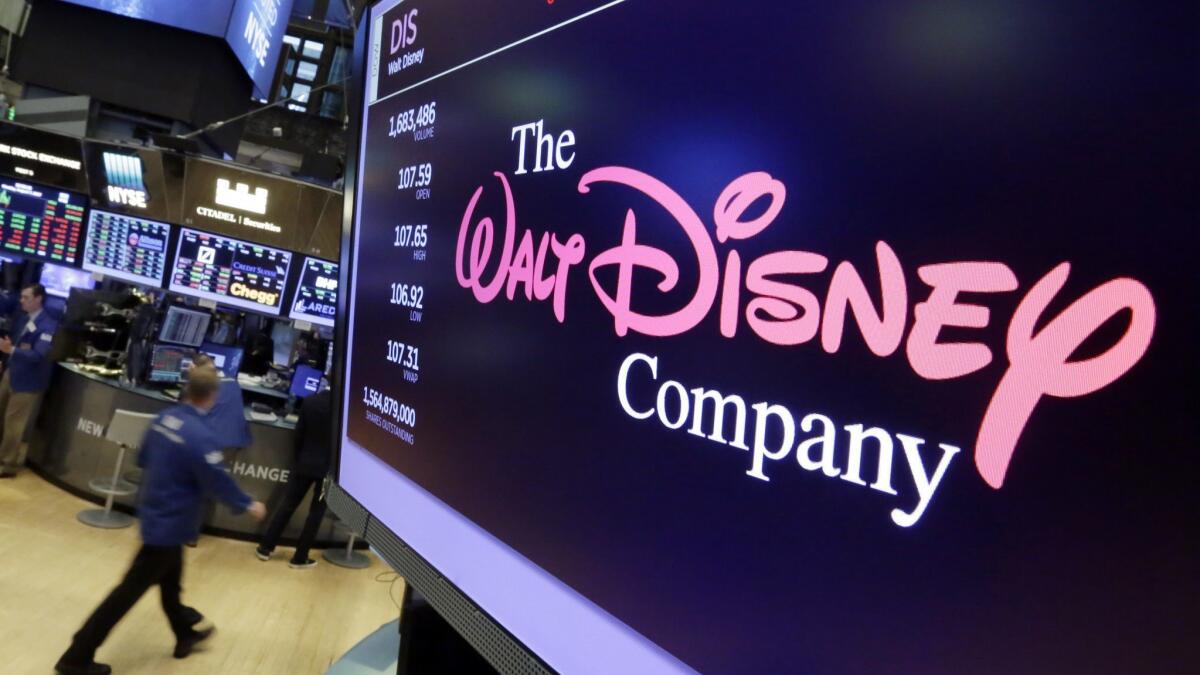Disney stops airing Netflix ads on ABC, FX, Freeform and National Geographic

- Share via
With the high-stakes streaming wars looming, Walt Disney Co. has stopped running commercials from Netflix Inc. on its general entertainment TV channels, which include ABC, Freeform, FX and National Geographic.
Disney’s new policy of rejecting the ads came this summer, as the Burbank entertainment giant stepped up plans to become a streaming giant itself, according to a person familiar with the move who was not authorized to speak publicly. Once business partners, Netflix and Disney now are on different footing: They’re direct competitors in an increasingly intense corner of the business.
Disney already has been pulling back much of its programming from Netflix’s streaming service, including movies such as “Finding Dory,” “Moana,” “Pooh’s Grand Adventure” and Marvel Entertainment franchises. The ad policy change represents a further hardening of Disney’s stance.
“It might be the Magic Kingdom, but don’t be fooled, those guys are hard-nosed businessmen,” said Mike Vorhaus, owner of the consulting firm Vorhaus Advisors. “Disney is serious about making its streaming service work.”
The move was not a surprise. Disney’s policy change on advertisements mirrors a long-standing practice in the television industry: Networks do not accept commercials for shows that run on a competing network. For example, ABC doesn’t air ads for “This Is Us,” which runs on NBC, or “Young Sheldon,” which runs on CBS. There are limited exceptions. Disney does accept ads from competitors on its annual Oscars telecast on ABC. And Disney’s channels have carried ads from competitor Comcast Corp., which owns NBCUniversal, to trumpet live events such as the Olympics.
“Broadcasters have never accepted each other’s ads,” Laura Martin, media analyst with Needham & Co., said Friday. “But this represents a broadening of Disney’s definition of who its competitors are.”
Disney is preparing to launch its direct-to-consumer service, Disney+, on Nov. 12. The streaming service, which will be priced at $6.99 a month, will try to take on Netflix, Amazon.com Inc.‘s Prime Video and other streaming services.
The entertainment giant is betting big on its upcoming streaming service. It plans to spend more than $1 billion on original content in fiscal 2020, including a live-action remake of “Lady and the Tramp,” remakes of “Lizzie McGuire” and “High School Musical,” and a Star Wars series called “The Mandalorian.”
Disney isn’t the only media or technology company increasing its digital footprint. Apple also is preparing a streaming service, Apple TV+, that will debut Nov. 1. WarnerMedia, now owned by AT&T Inc., is looking to launch its own service called HBO Max next year. Comcast is working to introduce its own offering, Peacock, before next summer when it broadcasts the 2020 Olympics from Japan.
“The direct-to-consumer business has evolved, with many more entrants looking to advertise in traditional television, and across our portfolio of networks,” Disney said Friday in a statement. “While the initial decision was strictly advertising based, we reevaluated our strategy to reflect the comprehensive business relationships we have with many of these companies, as direct-to-consumer is one element.”
Disney said its ESPN networks would continue to accept Netflix commercials. But networks including ABC, Freeform, National Geographic, FX, FXX and Disney XD no longer will run Netflix ads. The company’s suite of channels targeted at children, including the Disney Channel and Disney Jr., have long eschewed commercials. Hulu, which is now owned by Disney, typically does not run ads from competitors, including Netflix.
Disney’s ad revenue won’t feel a pinch because Netflix wasn’t advertising much on Disney networks, according to people familiar with the matter.
Last year, Netflix spent $18.4 million to buy ads on Disney channels, according to iSpot TV, which measures TV advertising. The bulk of that — $12.5 million — went to the ABC broadcast network, and $5 million went to ESPN and ESPN2.
Netflix already was scaling back. During the first nine months of this year, Netflix spent $5.5 million for commercial time on Disney-owned channels, with $5 million of that placed on ABC. Those buys included about $3 million for spots during the Academy Awards.
“The decision for Disney to cut off Netflix was likely not so complex,” said Todd Krizelman, chief executive of MediaRadar, a New York firm that provides advertising insights for media companies including the Los Angeles Times. “Netflix already avoids enriching their competitor, avoiding over-concentration of Disney’s portfolio of television channels and websites” in its advertising buys.
Disney’s policy could be different for Apple Inc. and Amazon.com ads, because those companies continue to have other partnerships with Disney. In those cases, Disney ad executives will make decisions on a case-by-case basis, said the knowledgeable person. Disney is expected to continue to accept commercials that promote Apple’s iPhone, iPad and other products.
Last month, Disney CEO Bob Iger stepped down from the board of Apple, a post he had held since 2011. Analysts said at the time that Iger probably found himself increasingly behind “enemy lines” as the iPhone maker looks to further disrupt traditional television.
The Wall Street Journal first reported that Disney was banning Netflix ads.
Disney shares rose 1.7% to $130.27 on Friday.
Times staff writer Wendy Lee contributed to this report.
More to Read
Inside the business of entertainment
The Wide Shot brings you news, analysis and insights on everything from streaming wars to production — and what it all means for the future.
You may occasionally receive promotional content from the Los Angeles Times.











